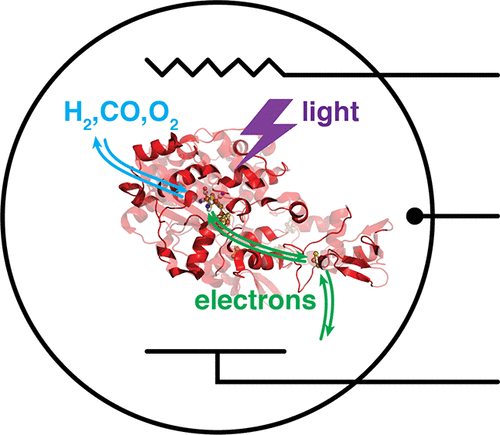当前位置:
X-MOL 学术
›
Acc. Chem. Res.
›
论文详情
Our official English website, www.x-mol.net, welcomes your feedback! (Note: you will need to create a separate account there.)
Electrochemical Investigations of Hydrogenases and Other Enzymes That Produce and Use Solar Fuels
Accounts of Chemical Research ( IF 18.3 ) Pub Date : 2018-03-08 00:00:00 , DOI: 10.1021/acs.accounts.7b00622 Melisa del Barrio 1 , Matteo Sensi 1 , Christophe Orain 1 , Carole Baffert 1 , Sébastien Dementin 1 , Vincent Fourmond 1 , Christophe Léger 1
Accounts of Chemical Research ( IF 18.3 ) Pub Date : 2018-03-08 00:00:00 , DOI: 10.1021/acs.accounts.7b00622 Melisa del Barrio 1 , Matteo Sensi 1 , Christophe Orain 1 , Carole Baffert 1 , Sébastien Dementin 1 , Vincent Fourmond 1 , Christophe Léger 1
Affiliation

|
Many enzymes that produce or transform small molecules such as O2, H2, and CO2 embed inorganic cofactors based on transition metals. Their active site, where the chemical reaction occurs, is buried in and protected by the protein matrix, and connected to the solvent in several ways: chains of redox cofactors mediate long-range electron transfer; static or dynamic tunnels guide the substrate, product and inhibitors; amino acids and water molecules transfer protons. The catalytic mechanism of these enzymes is therefore delocalized over the protein and involves many different steps, some of which determine the response of the enzyme under conditions of stress (extreme redox conditions, presence of inhibitors, light), the catalytic rates in the two directions of the reaction and their ratio (the “catalytic bias”). Understanding all the steps in the catalytic cycle, including those that occur on sites of the protein that are remote from the active site, requires a combination of biochemical, structural, spectroscopic, theoretical, and kinetic methods. Here we argue that kinetics should be used to the fullest extent, by extracting quantitative information from the comparison of data and kinetic models and by exploring the combination of experimental kinetics and theoretical chemistry.
中文翻译:

产生和使用太阳能的氢酶和其他酶的电化学研究
许多产生或转化小分子(例如O 2,H 2和CO 2)的酶嵌入基于过渡金属的无机辅因子。它们发生化学反应的活性位点被掩埋在蛋白质基质中并受到蛋白质基质的保护,并通过多种方式与溶剂连接:氧化还原辅助因子链介导长距离电子转移;静态或动态通道引导底物,产物和抑制剂;氨基酸和水分子转移质子。因此,这些酶的催化机理在蛋白质上是局域的,并且涉及许多不同的步骤,其中一些步骤决定了在压力条件下(极端氧化还原条件,抑制剂存在,光照),两个方向的催化速率下酶的反应。反应及其比例(“催化偏差”)。了解催化循环中的所有步骤,包括那些发生在远离活性位点的蛋白质位点上的那些位点,需要结合生物化学,结构,光谱,理论和动力学方法。在这里,我们认为应该充分利用动力学,方法是从数据和动力学模型的比较中提取定量信息,并探索实验动力学和理论化学的结合。
更新日期:2018-03-08
中文翻译:

产生和使用太阳能的氢酶和其他酶的电化学研究
许多产生或转化小分子(例如O 2,H 2和CO 2)的酶嵌入基于过渡金属的无机辅因子。它们发生化学反应的活性位点被掩埋在蛋白质基质中并受到蛋白质基质的保护,并通过多种方式与溶剂连接:氧化还原辅助因子链介导长距离电子转移;静态或动态通道引导底物,产物和抑制剂;氨基酸和水分子转移质子。因此,这些酶的催化机理在蛋白质上是局域的,并且涉及许多不同的步骤,其中一些步骤决定了在压力条件下(极端氧化还原条件,抑制剂存在,光照),两个方向的催化速率下酶的反应。反应及其比例(“催化偏差”)。了解催化循环中的所有步骤,包括那些发生在远离活性位点的蛋白质位点上的那些位点,需要结合生物化学,结构,光谱,理论和动力学方法。在这里,我们认为应该充分利用动力学,方法是从数据和动力学模型的比较中提取定量信息,并探索实验动力学和理论化学的结合。



























 京公网安备 11010802027423号
京公网安备 11010802027423号